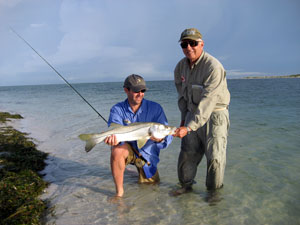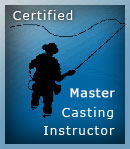Tactics and Flies for Beach Snook
When taking an early morning stroll along one of our many beaches, you will attract a lot of attention if you are waving a nine foot fly rod. As I write this, snook are beginning to leave their spring haunts and migrate to the nearby passes in preparation for their spawning activities. Daybreak seems to be the optimum time to search this trough of water adjacent to the sand, where a sharp eye will pick out snook either pursuing or waiting for the plentiful supply of smaller fish providing needed nutrition for the approaching spawn. What is needed to catch these beautiful battlers? Where are our best chances of finding cooperative linesiders?
 Most beach snook opportunities occur during the closed season. I prefer getting to isolated areas of beach by using either a boat or kayak. Once there, you can concentrate on fishing and not avoiding people with your back cast. Equipment should be easy for you to carry as you walk the beach. Wading booties are a good accessory to protect your feet from sharp objects. It is important to walk parallel to the surf and on the sand. Since getting in the water may only be necessary when releasing a fish. Most necessary accessories will fit in your shirt pockets. A fly box will carry your baitfish imitations. Look at the size and color of the bait that is most predominant in the surf. A three inch pattern is usually sufficient. Lefty’s deceiver is an old standard that produces. Newer synthetic materials are my preference with Polarfiber, Sea Fibers, and Neer Hair patterns heading the list. Most of these can be tied on a size one hook. Patterns that have all of the material on one side of the hook seem to give the best action. Large eyes are an added attraction. If tying your own, use something like Flex Loc to stiffen the material closest to the hook, preventing it from twisting around the shank causing an unnatural appearance. Go barbless! Getting into the habit of crimping all barbs will not hamper your catching ability. A hook without a barb penetrates with less force, yet can very easily be removed. White will be the predominant color in your selection. Some extra leader material and long nose pliers that have a cutting edge will be needed. Thirty pound Fluorocarbon is adequate for a bite tippet offering resistance to a raspy mouth and sharp gill rakers. Each time a fish is caught check the leader closely. Retie if abraded or, “chalky looking.” I prefer one of the newer clear sinking tip weight forward fly lines. Only a short three foot leader is needed here. A nine foot eight weight rod will fit the bill. Good Polaroid glasses and a hat with a dark underside brim will make seeing your quarry easier. Remember your shadow, when the sun is low. This is a sure way to frighten fish.
Most beach snook opportunities occur during the closed season. I prefer getting to isolated areas of beach by using either a boat or kayak. Once there, you can concentrate on fishing and not avoiding people with your back cast. Equipment should be easy for you to carry as you walk the beach. Wading booties are a good accessory to protect your feet from sharp objects. It is important to walk parallel to the surf and on the sand. Since getting in the water may only be necessary when releasing a fish. Most necessary accessories will fit in your shirt pockets. A fly box will carry your baitfish imitations. Look at the size and color of the bait that is most predominant in the surf. A three inch pattern is usually sufficient. Lefty’s deceiver is an old standard that produces. Newer synthetic materials are my preference with Polarfiber, Sea Fibers, and Neer Hair patterns heading the list. Most of these can be tied on a size one hook. Patterns that have all of the material on one side of the hook seem to give the best action. Large eyes are an added attraction. If tying your own, use something like Flex Loc to stiffen the material closest to the hook, preventing it from twisting around the shank causing an unnatural appearance. Go barbless! Getting into the habit of crimping all barbs will not hamper your catching ability. A hook without a barb penetrates with less force, yet can very easily be removed. White will be the predominant color in your selection. Some extra leader material and long nose pliers that have a cutting edge will be needed. Thirty pound Fluorocarbon is adequate for a bite tippet offering resistance to a raspy mouth and sharp gill rakers. Each time a fish is caught check the leader closely. Retie if abraded or, “chalky looking.” I prefer one of the newer clear sinking tip weight forward fly lines. Only a short three foot leader is needed here. A nine foot eight weight rod will fit the bill. Good Polaroid glasses and a hat with a dark underside brim will make seeing your quarry easier. Remember your shadow, when the sun is low. This is a sure way to frighten fish.
Snook always feed best when the tide is moving. Strong incoming tides in the morning present the best chances for me. Work the fly in long slow strips at first. If fish you can see show no interest, before changing patterns, vary your retrieve. The fly should not be coming straight at the snook’s face. A fleeing, panicky meal is much more appealing.
Heavy female snook will be mixed in with larger numbers of smaller males. The males are usually more aggressive and will feed voraciously. Find some structure close to one of our many Passes and you will find a Honey Hole. Riprap, wood, and sea walls with rubble, are examples of what snook like. It’s usually not necessary to cover a lot of ground. Once fish are located, these spots can be revisited at spaced intervals, giving time for the snook to settle down. On more than one occasion I have had tarpon moving along the beach within casting range. Your eight weight will provide a short burst of excitement if they are interested in your offering.
This type of fly fishing requires minimal equipment, is easily accessible if you live near water, and will provide you with some real fun. Take your fly rod for a walk!
![]()



